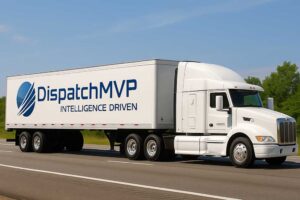When Dave Williams stepped into the role of chairman of the Truckload Carriers Association last year, he immediately set to work addressing issues faced by the industry and amplifying the voice of truckload on Capitol Hill. Over the past 12 months, he has worked to increase TCA members’ involvement in the creation of policies impacting the industry at both the federal and state levels. He is now preparing to pass the reins to TCA’s next chairman during Truckload 2024: Nashville in March. Recently, we had a chance visit with Williams about his tenure as chairman. During the conversation, he was quick say he believes it’s more important to look back at lessons learned than to point out achievements. Read on as Williams shares words of wisdom, along with his hopes and goals for the future of trucking.
Mr. Chairman, thank you for joining us for the last of your Chat with the Chairman interviews. As usual, it has been an eventful year for the trucking industry. What stands out most in your mind?
There have been a considerable number of good and positive things that stand out in my mind over the past year. It has truly been an honor to represent the TCA and its members. I am really excited about the direction we are headed as an association.
Maybe it’s a flaw of mine, but when I reflect on the past, I tend to gravitate toward lessons learned rather than celebrating accomplishments. One of the things that stands out in my mind this past year is how difficult an industry that this can be. Over the past year, we have endured — and are still enduring — one of the most challenging truckload cycles that we have ever experienced. We went from the highest of highs to some very tough trucking. We saw general rates drop to pre-pandemic levels while costs in just about every area went through the roof. Some fleets prepared for this difficult cycle by building a strong balance sheet while others found ways to insulate and differentiate their service offerings to survive the storm. I am hopeful we will see some daylight at the end of this tunnel sometime soon.
I think this just highlights how important it is for companies to be actively engaged members of the TCA. This is the place to learn and implement best practices by interacting with other fleets and experts. This is also the place to understand and take action on what needs to be done to ensure the long-term financial viability of our industry.
It’s also been a busy 12 months for TCA. What growth have you noticed in the association during your chairmanship?
There is a statement I’ve heard from one of my mentors on many occasions: “I am not here to make you happy; I am here to help you succeed.” Associations can sometimes get caught up in chasing a lot of the activities they think members might enjoy. While there’s nothing wrong with having a good time, I don’t think that’s why our members join TCA. At the end of the day, we have an obligation to help our members survive — and then thrive. That is where we create value. This doesn’t mean we won’t continue to provide many of the fun things that associations can provide, including important networking opportunities. It means that our focus has shifted toward elevating activities that bring genuine business value, such as timely information sharing, real-world education that results in better business decisions, industry-leading benchmarking opportunities, effective government advocacy, and access to a variety of industry experts, to name a few. We have always provided these things at some level, but we are really stepping up our game in strengthening each of these important areas. We are focusing our energy on activities that pay valuable dividends and show up in the actual results for our members. I really believe we are making significant progress here. We have a tremendous opportunity to really do some good, and it’s starting to show. Very exciting!
TCA has a mission to give the truckload segment a clear voice on Capitol Hill. What topics have been the main focus of that voice during the past year, and what progress have you seen?
Giving the truckload industry a voice on Capitol Hill is a process that started several years ago and has been building every year. For many of our larger fleets, the function of government advocacy is the most valuable benefit of being part of an association, whether it’s at the state level or the national level. During the first few years of Capitol Hill visits with the TCA, we had to spend a good amount of time familiarizing members of Congress and the Federal Regulatory Agencies with the TCA. There was not a general knowledge about TCA because we had not actively lobbied for several decades. Now they know who we are. They are asking for our input on issues. They are listening to our concerns. I am really grateful for the TCA members and staff who have invested time and resources to put us in this position. We will continue to build on this and create more value for the industry.
We have also been consciously moving away from having to play defense all the time. For much of my career, every year felt like a superhero movie. Most of our efforts went into getting the industry all worked up about bad ideas coming out of Washington that might lead to the “end of the world” for our industry. If we defeated a bad idea, it was considered a great success. However, that was only half of the equation. We needed to develop a different approach, and we did. This past year, we furthered that effort by articulating a focused understanding of what we’re actually trying to accomplish. Specifically, we are working toward improving the driving job, improving highway safety, helping fleets become more financially sustainable, charting an appropriate environmental course, and improving the image of this industry. This has given us a foundation to start playing more offense and push for ideas and legislation that will help us to become a stronger industry. It is a different mindset that I believe will continue to change the way we operate from an advocacy perspective.
During our first conversation last March, when you assumed chairmanship of TCA, you were asked to share your thoughts on the most important issue facing trucking. At that time, you expressed a desire for the industry to move from “survival mode” into a pattern of growth and success, with leaders looking ahead to address and overcome challenges. How has the industry progressed since then?
In short, we still have a lot of work to do. If anything, we have fallen into a deeper downcycle over the past 12 months. The inevitable result of that will be many fleet bankruptcies. It’s a cruel market.
But this also highlights the need to really understand how various policies impact our industry. One of the most basic principles our industry has a really hard time grasping is the economic law of supply and demand. Even if demand remains constant, when supply increases then prices fall. When supply decreases then prices rise. It’s very simple. We saw that play out through the pandemic and after the pandemic. We’ve seen this play out every couple of years for the last three-plus decades.
Supply in this case is a form of tractor capacity. That capacity can be impacted by a number of factors, including the availability of tractors, the availability of drivers, the availability of hours of service, and equipment size and weight, to name a few. Ideally, cycles would be caused by demand — meaning how much freight needs to be moved in a time period based on consumer buying, manufacturing output, business investment, etc. But through time, it seems the majority of truckload cycles (especially this one) are primarily driven on the supply side — the side we have the most impact on. When things get really good, the industry’s “eyes” tend to get bigger than those of a football player at an all-you-can-eat buffet line, and it organically grows, leading to an overbuy of tractors.
On top of that, there are groups within the industry that often push for policies that compound the issue. Examples of this might include:
- More hours-of-service or hours-of-service flexibility. This is a doubled edged sword. We want to help our drivers out, but are we exchanging more work for less pay?
- Lowering the barriers to entry. Programs like the younger driver program can actually hurt the pay of a veteran driver by not allowing the full impact of supply and demand to run its course.
- Higher weight or length limits. More often than not, the efficiencies gained through size and weight are not fully compensated through the truckload market, especially when that efficiency becomes the norm.
So, while many of these things feel good in the short term — especially when things are tough — they can actually be quite harmful in the long term. As long as the greater portion of the industry remains in survival mode, we will continue to think short-term and struggle to make long-term progress. When you look at the LTL industry, it’s an industry that has generally figured this out. Among the public LTL companies and their truckload counterparts, the LTL companies have substantially higher price-to-earnings ratios (meaning that they are worth more even if they are the same size). The LTL rate environment is also much more stable and less susceptible to volatile cycles. It’s as clear as day, but we keep making the same mistakes. Hopefully, at some point, our industry will begin to understand the correlations.
As political parties and candidates move into high gear during this presidential election year, how do you see political agendas impacting the trucking industry?
Despite all the bipartisan battles and all the bickering that occurs, the structure of the government in this country is really a beautiful thing. Checks and balances are a beautiful thing. Sometimes those checks and balances work for you and sometimes they work against you, but in the end everything should even out.
What has really changed in my opinion over the past decade or so is the increasing role of presidential executive orders and activist regulatory agencies. These shifts have placed a greater emphasis on the influence of the White House. In the grand scheme of things, I strongly believe Congress should make the rules and the agencies should enforce the rules. A balanced government usually results in a better government. We are seeing the impact from these executive orders and agency moves more and more in the areas of environmental and labor law. This is where near-term elections will likely play the biggest role. Outside of environment and labor, the other significant area to watch is tax policy.
I don’t think it is our place as an association to align ourselves with a certain party — but we can align with candidates who will help preserve our ability to operate our businesses successfully. The most direct impact an individual can make is through their vote. But there are also opportunities to educate and advocate. Trucking is not a Republican or a Democrat priority; it is an American priority. Trucking is critical to the continued economic success of this country. We need to keep reminding our elected officials of that.
The race to achieve zero emissions in every sector, including trucking, is always a topic of hot debate. In a sea of changing legislation, regulations, and deadlines, what would you point to as the most important piece of information for motor carriers?
This has been a very confusing journey for fleets. Regional rules, state rules, and national rules with different requirements and timelines have created a jumbled mess. To make things even more challenging, some of the regional and state rules in California have not followed the requirements of the Clean Air Act, which gives the industry adequate time to prepare for compliance. In the case of California, changes and tweaks to the rules are being made right up until the deadline for compliance. This has been a source of great frustration for the industry.
The most important thing a motor carrier can do is stay informed. This is a difficult task, especially for smaller carriers that don’t have the extra resources. But you cannot claim you didn’t know — that is not a good strategy. The federal rules are generally easier to follow and typically only apply to new equipment going forward.
Many of the California rules are much more complex and have some element that applies to existing fleets. In California, there are several rules that were implemented on January 1, 2024 (i.e., the Advanced Clean Fleet Rule, the Drayage registry changes, the Transport Refrigeration Unit Rule, and the new warehouse rule to name a few) that require some sort of reporting requirement fleets must file with the state. If you are unsure whether you need to report, I would err on the side of caution. In some cases, the California rules then progress towards prohibiting certain types or age bands of equipment from operating in the state. As other states consider implementing various portions of the California rules, it creates nothing but confusion.
As an association we have called upon the EPA to stand up and lead. We do not need a new rule every time you cross a state line. We need a national standard that allows for the efficient flow of interstate commerce. Whether the federal government has the means or the will to accomplish that will remain to be seen.
As work continues on the accuracy and safety of autonomous systems, from basic driver-assistance software to self-driving trucks, how do you see this technology impacting motor carriers?
There have been some really interesting advancements in the world of equipment technology taking place over the past eight or 10 years. While progress has not materialized for autonomous truck developers as many had thought, we have learned some valuable lessons and insights. To truly implement autonomous technology, I believe a few things need to happen:
- Developers need to create greater technical stability — creating more durable sensors that can survive harsh environments, making the software systems more robust, etc.
- Developers need to expand the functional capabilities of the technology. Ramp-to-ramp or hub-to-hub technology in the truckload sector leaves a lot to be desired. The drayage moves required at both ends of the move make it very difficult operationally. Door-to-door functionality is really what needs to happen in order to create value for our industry.
- Developers need to achieve some sort of regulatory and societal acceptance of autonomous tech in large trucks. Legislation proposed in California, New York, and Indiana to ban this technology is an early indication this is not going to be easy.
- Developers need to create an economic model that is sustainable for themselves and for fleets. That is an entire conversation in and of itself.
In the meantime, what I see the biggest benefit from this whole experience is the potential of implementing various portions of the technology in today’s trucks to help our drivers. We can use lane-centering technology today to improve safety and reduce fatigue. We can use the learnings from the additional sensors and computer logic to improve the accident mitigation or active braking systems. Part of this will require developers to invest some time in scaling down their vision of driverless trucks and focusing on what we can do today for our drivers. Overcoming the four issues I listed above is not insurmountable, but it will take time — and a lot more financial investment. With many of the developers running out of funding, we hope to salvage the lessons learned so far and put a portion of that technology to work.
Of course, a shortage of safe, available truck parking remains a concern for both drivers and carriers. During last fall’s annual Call on Washington, TCA members and staff gained additional sponsors in the House and Senate for the Truck Parking Improvement Act bills. Currently, TCA is helping legislators identify closed rest areas across the U.S. What are other steps motor carriers can take to help effect change?
Recently the U.S. Department of Transportation announced $292 million in grants to go toward truck parking. This is a win for the industry, and confirmation that our efforts are making a difference. We have much more to accomplish though, as these grants are concentrated in only a half dozen states, with some of the money going towards information systems rather than additional capacity.
We also need to recognize that this issue is more complex than just getting federal funds. We need to convince state, regional, and local planners to take truck parking into consideration when planning the future. We will never catch up if we’re constantly building new projects without consideration of truck parking.
As an example, one of the big challenges comes in the building of new warehouse space. Most of these projects are built on a plot of land that maximizes the footprint of the warehouse. Then, many of these builders will post “No Truck Parking” signs on the streets surrounding the warehouse. This shifts the burden of the impact of that building onto the truck driver and the surrounding community as the driver tries to find a place to park until the delivery appointment. It’s not right. Every warehouse should have an obligation to accommodate the impact of its existence by providing some amount of on-site truck parking. That can be done locally or regionally through zoning laws. That is going to require us to engage local lawmakers — which will require our members to build support in their communities.
TCA has also been working to gather information on shuttered rest stops across the country. As an industry, we can put pressure on the states and counties that operate these rest stops to open them and provide immediate relief. This is an issue with many layers. There is a lot to be done, and this will require all of our best efforts.
Traditionally, we ask the outgoing chairman to give advice to the incoming chairman each year. What would be your advice to John Culp of Maverick Transportation, who will soon be stepping into your shoes?
I am really excited for our incoming chairman. John Culp is an extremely capable leader and has my full support. I consider John a friend and am looking forward to seeing him continue to influence the direction of the TCA. If anything, I would seek advice from him rather than the other way around. If he ever needs my help, I will always be there for him.
Thank you, Mr. Chairman. It has truly been a pleasure working with you over the past 12 months.
This article originally appeared in the March/April 2024 edition of Truckload Authority, the official publication of the Truckload Carriers Association.
Linda Garner-Bunch has been with The Trucker since 2020, picking up the reins as managing editor in 2022. Linda has nearly 40 years of experience in the publishing industry, covering topics from the trucking and automotive industry to employment, real estate, home decor, crafts, cooking, weddings, high school sports — you name it, she’s written about it. She is also an experienced photographer, designer and copy editor who has a heartfelt love for the trucking industry, from the driver’s seat to the C-suite.
















Hello it’s a pleasure to join the team.